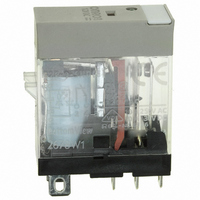G2R-1-SND-DC12(S) Omron, G2R-1-SND-DC12(S) Datasheet - Page 16

G2R-1-SND-DC12(S)
Manufacturer Part Number
G2R-1-SND-DC12(S)
Description
RELAY SPDT 12VDC PLUG-IN W/LED
Manufacturer
Omron
Series
G2RSr
Datasheets
1.G2R-1A-E-DC12.pdf
(30 pages)
2.G2R-1A-E-DC12.pdf
(14 pages)
3.G2R-1-S_DC12S.pdf
(12 pages)
Specifications of G2R-1-SND-DC12(S)
Relay Type
General Purpose
Contact Form
SPDT (1 Form C)
Contact Rating (current)
10A
Switching Voltage
440VAC, 125VDC - Max
Coil Type
Standard
Coil Current
43.2mA
Coil Voltage
12VDC
Turn On Voltage (max)
8.4 VDC
Turn Off Voltage (min)
1.8 VDC
Mounting Type
Socket
Termination Style
Quick Connect - .187" (4.7mm)
Circuit
SPDT (1 Form C)
Contact Rating @ Voltage
10A @ 250VAC
Control On Voltage (max)
8.4 VDC
Control Off Voltage (min)
1.8 VDC
Coil Voltage Vdc Nom
12V
Contact Current Max
10A
Contact Voltage Ac Nom
250V
Contact Voltage Dc Nom
30V
Coil Resistance
278ohm
Contact Configuration
SPDT
Lead Free Status / RoHS Status
Lead free / RoHS Compliant
Other names
G2R-1-SNDDC12(S)
G2R-1-SNDDC12(S)
G2R1SNDDC12S
Z2952
G2R-1-SNDDC12(S)
G2R1SNDDC12S
Z2952
Available stocks
Company
Part Number
Manufacturer
Quantity
Price
Company:
Part Number:
G2R-1-SND-DC12(S)
Manufacturer:
Omron Electronics Inc-IA Div
Quantity:
135
PCB Design
■ Soldering
As demands for more compact electronic devices have grown, so
have demands declined for the plug-in relays that requires a bulky
socket for connection. This trend has lead to the development of
relays that can be soldered directly onto the PCB. Smaller relays
have made possible great density increases on the PCB, which in
turn reduces the size of the product or device. However, unless the
relay is fully sealed, when soldered onto a PCB, flux may penetrate
into the housing, adversely affecting the internal circuitry.
The following points will help when designing a product which uses
relays. This section points out details to be noted when soldering a
relay to a PCB.
■ PCB Materials
Generally, the substrate of a PCB is made of glass epoxy (GE),
paper epoxy (PE), or paper phenol (PP). Of these, the glass-epoxy or
paper-epoxy PCB is recommended for mounting relays. See the fol-
lowing table
■ PCB Thickness
PCBs having a thickness of 0.8, 1.2, 1.6, or 2.0 mm are generally
used. A PCB that is 1.6 mm thick is best for mounting a PCB relay,
considering the weight of the relay and the length of the terminals.
(The terminal length of OMRON relays is 3, 3.5, or 4.0 to 5.0 mm.)
■ Terminal Hole Diameter and
Select the appropriate terminal hole and land diameters from the fol-
lowing table, based on the PCB mounting hole drawing. Land diame-
ters may be reduced to less than those listed below if the through-
hole connection process is to be employed.
16
Electrical characteristics
Mechanical characteristics
Cost Effectiveness
0.6 mm
0.8 mm
1.0 mm
1.2 mm
1.3 mm
1.5 mm
1.6 mm
2.0 mm
Land Diameter
Normal
Terminal Hole Diameter
Item
Electromechanical Relays
Terminal Hole and Land Diameters
3.5
±0.1 mm
Tolerance
resistance hardly affected by humidity.
change in temperature or humidity.
Suitable for through-hole PCBs and
multi-layered PCBs.
Expensive
High insulation resistance. Insulation
Little expansions/shrinkage caused by
Glass Epoxy (GE)
1.5 mm
1.8mm
2.0mm
2.5mm
2.5mm
3.0mm
3.0mm
3.0mm
Minimum Land
Technical Information
Diameter
Epoxy Based
Fair
Fair
Fair
■ PCB Selection
In general, relays are directly mounted and soldered onto a PCB.
Although seemingly an uninvolved process, soldering and its related
processes of flux application, relay mounting, heat application, and
washing can be detrimental to a relay’s performance. For example, if
the PCB were to warp, the internal mechanism of the relay could
become distorted, degrading the performance characteristics. Thus it
could be said that the relay’s characteristics are also affected by the
size, thickness, and material of the PCB. Therefore, carefully select a
PCB that will not jeopardize the performance of the relay.
■ Shape of Lands
The land section should be on the center line of the copper-foil pat-
tern, so that the soldered fillets become uniform.
A break in the circular land area will prevent molten solder from filling
holes reserved for components which must be soldered manually
after the automatic soldering of the PCB is complete.
Correct
Incorrect
Paper Epoxy (PE)
Insulation resistance degraded by hu-
midity.
Much expansion/shrinkage caused by
changes in temperature or humidity.
Not suitable for through-hole PCB.
Fair
0.2 to 0.5 mm
Break in land
Paper Phenol (PP)
Phenol-based


















